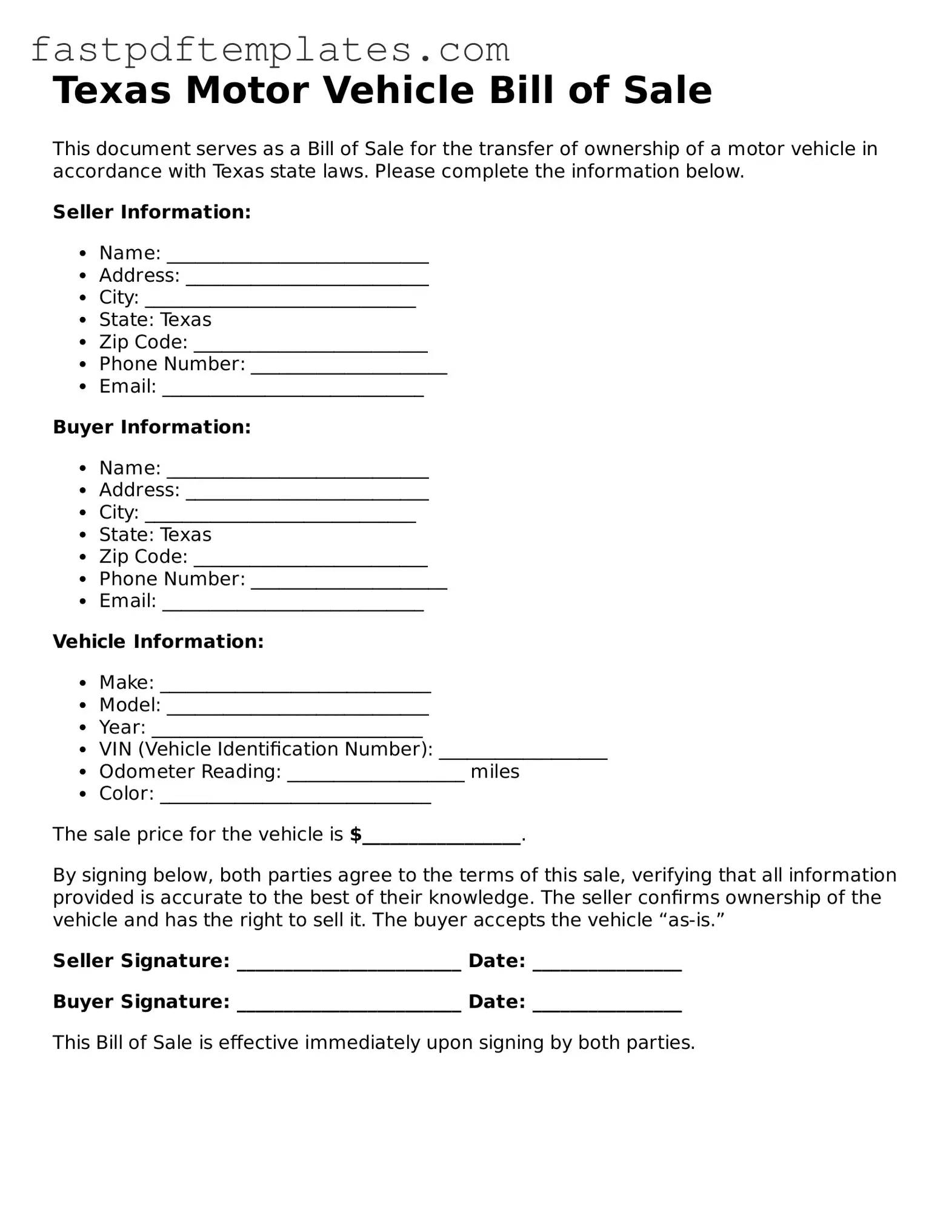The Texas Vehicle Registration Application is similar to the Bill of Sale as both documents are essential for transferring ownership of a vehicle. While the Bill of Sale serves as proof of the sale, the Vehicle Registration Application is used to register the vehicle in the new owner's name. Both forms require information about the vehicle, such as the Vehicle Identification Number (VIN), make, model, and year. They also typically require the seller's and buyer's information, ensuring that the transfer is documented correctly.
The Texas Title Application shares similarities with the Bill of Sale in that it is also involved in the process of transferring ownership. The Title Application is submitted to the Texas Department of Motor Vehicles to obtain a new title for the vehicle. Like the Bill of Sale, it requires details about the vehicle and both parties involved in the transaction. This document is crucial for establishing legal ownership, making it an essential companion to the Bill of Sale.
The Vehicle Transfer Notification form is another document that aligns closely with the Bill of Sale. This form is used to notify the Texas DMV that a vehicle has been sold or transferred. It helps protect the seller from any future liabilities related to the vehicle after the sale. Both documents require similar information about the vehicle and the parties involved, ensuring a clear record of the transaction.
The Texas Application for a Duplicate Title is also comparable to the Bill of Sale. If a vehicle's title is lost or damaged, this application allows the owner to request a duplicate. While the Bill of Sale is used during a sale, the Duplicate Title Application serves to maintain proper documentation of ownership. Both documents emphasize the importance of having accurate and up-to-date records regarding vehicle ownership.
The Affidavit of Heirship for a Motor Vehicle is another document that relates to the Bill of Sale. This affidavit is used when a vehicle is inherited and is necessary for transferring ownership without a formal title. Similar to the Bill of Sale, it provides a legal declaration of ownership and requires information about the deceased owner and the new owner. This document helps facilitate the transfer of ownership in situations where a title may not be available.
The Texas Vehicle Inspection Report can also be seen as similar to the Bill of Sale. While the Bill of Sale documents the sale of the vehicle, the Inspection Report verifies that the vehicle meets safety and emissions standards. Both documents are often required during the sale process and provide important information about the vehicle's condition. They work together to ensure that the buyer is informed and that the transaction is compliant with state regulations.
The Texas Odometer Disclosure Statement is another important document that parallels the Bill of Sale. This statement is required when a vehicle is sold and provides a record of the vehicle's mileage at the time of sale. Both documents protect the interests of the buyer and seller by ensuring transparency regarding the vehicle's condition and history. They are often completed simultaneously during the sale process.
The Bill of Sale for a Boat or Watercraft is similar in purpose to the Motor Vehicle Bill of Sale, as both documents serve to transfer ownership of a vehicle or vessel. Each document requires details about the item being sold, such as identification numbers and descriptions. They also collect the necessary information about the buyer and seller to ensure a legal transfer of ownership, making them crucial for both land and water vehicles.
The Motorcycle Bill of Sale is another document that functions similarly to the Motor Vehicle Bill of Sale. It serves the same purpose: to document the sale and transfer of ownership of a motorcycle. Both forms require similar information about the vehicle, including make, model, and VIN, as well as details about the buyer and seller. This ensures that ownership is legally recognized and that both parties are protected during the transaction.
Finally, the Texas DMV Change of Address form bears some resemblance to the Bill of Sale. While it doesn’t deal directly with the sale of a vehicle, it is important for keeping records up-to-date. When a vehicle is sold, the new owner must update their address with the DMV. Both documents are essential for maintaining accurate records and ensuring that the vehicle's registration reflects the current owner’s information.
